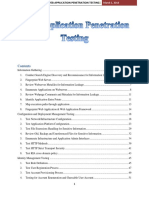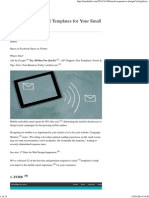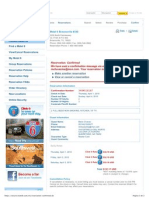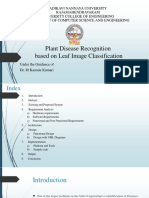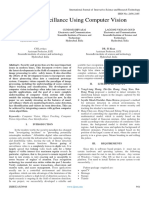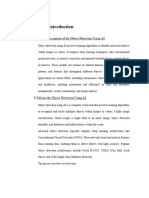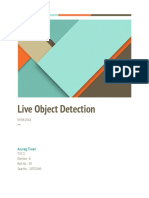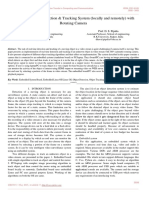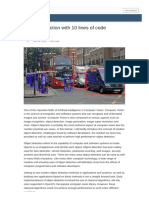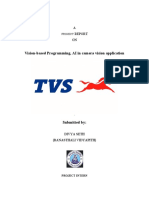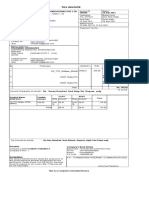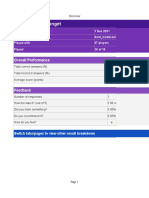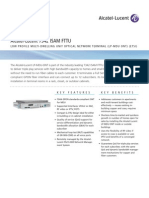Professional Documents
Culture Documents
Automatic Image Detection and Censoring On Web Pages
Original Title
Copyright
Available Formats
Share this document
Did you find this document useful?
Is this content inappropriate?
Report this DocumentCopyright:
Available Formats
Automatic Image Detection and Censoring On Web Pages
Copyright:
Available Formats
Volume 5, Issue 6, June – 2020 International Journal of Innovative Science and Research Technology
ISSN No:-2456-2165
Automatic Image Detection and
Censoring on Web Pages
Adithye Joseph1, Ajay Chacko Thomas1, Jobin Jose1, Divya Sunny2
1
UG Student, Dept. of CSE, SJCET Palai, Kerala, India
2
Assistant Professor, Dept of CSE, SJCET Palai, Kerala, India
Abstract:- AIDC(Automatic Image Detection And off and access other controls. The users/children can now
Censoring) is a software that utilizes AI and Machine access the internet via the web browser on the computer.All
learning to automatically detect and censor the contents the content they access will now be automatically censored
on a web page. As we all know ,the internet is a vast by AIDC. As the control panel of the censoring system is
space with enormous amount of data and content in it password protected the users cannot make any changes to
and a large portion of these contents are pornographic the settings set by the administrator. The control panel
and violent images and videos.And the current situation gives the administrator access to various settings such as
is such that even a child can easily access these contents. excluding certain websites from being censored.The
So what AIDC aims to provide is a software that can be administrator can also turn off the censoring when
installed on the computer that will automatically censor required.The software primarily focuses on blurring of guns
these contents and thus keeping the young minds safe on to abstract the idea of violent image censoring on online
the internet.This feature can controlled by an content.Censoring is only done on necessary areas so as to
administrator.Due to limitations,the scope of this preserve the meaning of the image.This method is far
project will include only censoring of violent images. superior to existing methods which completely blurs or
hides the image destroying its intended purpose.
I. INTRODUCTION
II. PROPOSED METHOD
The easy access and widespread of the Internet makes
it easier than ever to reach content of any kind at any The working of the entire process is as
moment, and while that poses several advantages, there is follows:Webscraper extracts images from the web page.The
also the fact that sensitive audiences may be inadvertently images are then stored in a folder locally.An image
exposed to violent content they did not ask for.AIDC aims detection model then access this folder to retrieve images
to provide is a software that can be installed on the from it.The images are then processed by the model to
computer that will automatically censor these contents and detect the relevant object.A masking algorithm generates a
thus keeping the young minds safe on the internet.After mask for the object concurrently.The mask is then placed
installing the AIDC plug-in/software the admin of the on the object to generate the censored image.The image is
system or the parent can access the AIDC control panel then send back to be viewed bytheuser.
which allows him/her to turn the censoring system on and
Chart 1:- Overall Design
The entire project can be divided into three sections. B. Detection of Objects
Here object detection is done using Mask R-
A. Extraction of Images CNN.Mask RCNN is a deep neural network aimed to solve
A custom made webscraper is made to extract images instance segmentation problem in machine learning or
from webpages. A web crawler is used to browses the computer vision. In other words, it can separate different
internet to index and search for content by following links objects in a image or a video. You give it a image, it gives
and exploring.A web scraper is a specialized tool designed you the object bounding boxes, classes and masks.We use a
to accurately and quickly extract data from a web page. custom data set of guns to train this model .
Web scraper used here collects only images.First, a scraper
unique to your project, designed specifically to target and C. Masking
extract the data you want from the websites you want it A mask is applied to the object to produce the
from. censored image.
IJISRT20JUN709 www.ijisrt.com 891
Volume 5, Issue 6, June – 2020 International Journal of Innovative Science and Research Technology
ISSN No:-2456-2165
This image is then given back to the browser to be A. Training Phase
viewed by the user. In this phase we create a dataset and annotate
them.The dataset contains almost 250 images. Validation
III. EXPERIMENTAL ANALYSIS set contains almost 100 images.
The image censoring section of the proposed system
consists of two parts testing phase and training phase.The
image is acquired through web browser.
Fig 1:- Dataset
B. Testing Phase
In this phase we evaluate the performance of the model. We adopt image-centric training. Images are resized such that their
scale (shorter edge) is 800 pixels. Each mini-batch has 2 images per GPU and each image has N sampled RoIs, with a ratio of 1:3
of positive to negatives.
Fig 2:- Test Phase Evaluation
IV. SOFTWARE IMPLEMENTATION D. Keras API
The Keras functional API used create models that is
A. Python more flexible than other API’s. This functional API used to
It used for processing and visualization of the data.It handle non-linear topology, shared layers, and multiple
is used for initial segmentation and generation of attribute inputs or outputs.
tables for data processing. It is also used to create
webscraper E. Anaconda
It is used to set up a platform for creating the object
B. Tensor flow detection model.It is integrates tensorflow and keras api
The fetched image is analyzed based on the factors into the training model.
such as slope,NDVI etc and these images are processed for
further scanning for predicting the output. V. HARDWARE IMPLEMENTATION
C. MS COCO Dataset 1 TB Hard disk
It is used for initial segmentation and detection.The 8 GB RAM minimum
pre trained model on MS COCO forms the basis for the Processor intel i5 or above
later model. GPU gtx 1050 or above
3 GB minimum vram
IJISRT20JUN709 www.ijisrt.com 892
Volume 5, Issue 6, June – 2020 International Journal of Innovative Science and Research Technology
ISSN No:-2456-2165
VI. FUTURE SCOPE polishing and performance improvement can be done in
future to make it more appealing to general public.
The project in the future, can be further expanded by
improving the detection accuracyand reducing load VII. RESULT
times.Few ways it could be achieved is by Improving
model accuracy by adding more images to data set,reducing The model shows almost 80% accuracy in test
the dependency on on board hardware,Implementing the performed. We used cross validation for training
software entirely on a SaaS platform to make it more dataset.This software provides a more advanced to deal
flexible, adding more user friendly features.Much more with explicit images in webpages. The webpage with this
software running in background is shown below.
Fig 3:- Webpages after censoring.
VIII. CONCLUSION REFERENCES
The proposed system helps to censor violent and [1]. M. Andriluka, L. Pishchulin, P. Gehler, and B.
explicit images on webpages.This provides an efficient and Schiele. 2D human pose estimation: New benchmark
easy way to protect children from this type of content in and state of the art analysis. In CVPR, 2014.
internet.Also this project provides a platform for further [2]. P. Arbela ́ez, J. Pont-Tuset, J. T. Barron, F. Marques,
development of automatic censoring of unwanted content and J. Malik. Multiscale combinatorial grouping. In
on internet. CVPR, 2014.
[3]. A. Arnab and P. H. Torr. Pixelwise instance
segmentation with a dynamically instantiated network.
In CVPR,2017.
[4]. M. Bai and R. Urtasun. Deep watershed transform for
in- stance segmentation. In CVPR, 2017.
IJISRT20JUN709 www.ijisrt.com 893
Volume 5, Issue 6, June – 2020 International Journal of Innovative Science and Research Technology
ISSN No:-2456-2165
[5]. S. Bell, C. L. Zitnick, K. Bala, and R. Girshick.
Inside- outside net: Detecting objects in context with
skip pooling and recurrent neural networks. In CVPR,
2016.
[6]. Z. Cao, T. Simon, S.-E. Wei, and Y. Sheikh. Realtime
multi- person 2d pose estimation using part affinity
fields. In CVPR, 2017.
[7]. M. Cordts, M. Omran, S. Ramos, T. Rehfeld, M.
Enzweiler, R. Benenson, U. Franke, S. Roth, and B.
Schiele. The Cityscapes dataset for semantic urban
scene understanding. In CVPR, 2016.
[8]. J. Dai, K. He, Y. Li, S. Ren, and J. Sun. Instance-
sensitive fully convolutional networks. In ECCV,
2016.
[9]. J. Dai, K. He, and J. Sun. Convolutional feature
masking for joint object and stuff segmentation. In
CVPR, 2015.
[10]. J. Dai, K. He, and J. Sun. Instance-aware semantic
segmen- tation via multi-task network cascades. In
CVPR, 2016.
IJISRT20JUN709 www.ijisrt.com 894
You might also like
- Web Application Security TestingDocument179 pagesWeb Application Security TestingtomwmsvaNo ratings yet
- Real Time Object Detection Using SSD and MobileNetDocument6 pagesReal Time Object Detection Using SSD and MobileNetIJRASETPublicationsNo ratings yet
- Occult Science in India Louis Jacolliot 1 Ebook PDFDocument2 pagesOccult Science in India Louis Jacolliot 1 Ebook PDFMacka100% (1)
- Communication ChannelsDocument12 pagesCommunication ChannelsAshwini Kumar100% (1)
- Facial Recognition Using Deep LearningDocument6 pagesFacial Recognition Using Deep LearningInternational Journal of Innovative Science and Research TechnologyNo ratings yet
- Handwritten Letter Recognition Using Artificial Intelligence'Document9 pagesHandwritten Letter Recognition Using Artificial Intelligence'IJRASETPublicationsNo ratings yet
- The Effects of TikTok On The Students of BFCSIDocument42 pagesThe Effects of TikTok On The Students of BFCSIgfpandumaNo ratings yet
- 32 Responsive Email Templates For Your Small BusinessDocument13 pages32 Responsive Email Templates For Your Small BusinessPrabhul Kumar0% (1)
- Motel 6 Discount Motel Rooms - Budget Motel - by Motel 6Document2 pagesMotel 6 Discount Motel Rooms - Budget Motel - by Motel 6Mario ChávezNo ratings yet
- Plant Disease Recognition Based On Leaf Image ClassificationDocument29 pagesPlant Disease Recognition Based On Leaf Image Classificationravi tejaNo ratings yet
- A Facial Recognition SystemDocument4 pagesA Facial Recognition SystemIJRASETPublicationsNo ratings yet
- Image Processing - Using Machine Learning: Software Requirement SpecificationDocument19 pagesImage Processing - Using Machine Learning: Software Requirement Specification9609762955No ratings yet
- Smart Surveillance Using Computer VisionDocument4 pagesSmart Surveillance Using Computer VisionInternational Journal of Innovative Science and Research TechnologyNo ratings yet
- Computer Vision AlgorithmsDocument4 pagesComputer Vision Algorithmsvickydivi09No ratings yet
- Suspicious Activity Detection and Alert System Using Raspberry PiDocument5 pagesSuspicious Activity Detection and Alert System Using Raspberry PiInternational Journal of Innovative Science and Research TechnologyNo ratings yet
- Chapter-3 Modal Implementation and AnalysisDocument23 pagesChapter-3 Modal Implementation and AnalysisAbbey Benedict TuminiNo ratings yet
- Facial Authentication Using Deep-Learning: An Advanced Biosecure Login Model Employing An Integrated Deep-Learning Approach To Enhance The Robustness and Security of The Login Authentication ProcessDocument7 pagesFacial Authentication Using Deep-Learning: An Advanced Biosecure Login Model Employing An Integrated Deep-Learning Approach To Enhance The Robustness and Security of The Login Authentication ProcessInternational Journal of Innovative Science and Research TechnologyNo ratings yet
- Android FFFDocument31 pagesAndroid FFF201801330028No ratings yet
- BE Project PresentationDocument29 pagesBE Project PresentationBEETB217Ameya NerkarNo ratings yet
- ch1Document8 pagesch1aditya mishraNo ratings yet
- Face Recognition With 2D-Convolutional Neural NetworkDocument5 pagesFace Recognition With 2D-Convolutional Neural NetworkSupreeth Suhas100% (1)
- Contour Based TrackingDocument20 pagesContour Based TrackingSahil SinghNo ratings yet
- Facial Recognition Using Deep LearningDocument8 pagesFacial Recognition Using Deep LearningPriyanka gopiNo ratings yet
- Batch 3Document23 pagesBatch 3Manoj KurraNo ratings yet
- Event Management System ProjectDocument10 pagesEvent Management System ProjectJani MuzaffarNo ratings yet
- Building CNN Model - Formatted PaperDocument7 pagesBuilding CNN Model - Formatted Paperoussama zemziNo ratings yet
- Face Recognition For Criminal DetectionDocument7 pagesFace Recognition For Criminal DetectionIJRASETPublicationsNo ratings yet
- Real Time Object Detection With Deep Learning and OpenCVDocument5 pagesReal Time Object Detection With Deep Learning and OpenCVSOWMYA SOWMINo ratings yet
- Driver Drowsiness and Face RecoDocument14 pagesDriver Drowsiness and Face RecoJohnn SneNo ratings yet
- Sat - 27.Pdf - Face Mask Detection Using Convolutional Neural NetworkDocument10 pagesSat - 27.Pdf - Face Mask Detection Using Convolutional Neural NetworkVj KumarNo ratings yet
- Face Detection System With Face RecognitionDocument8 pagesFace Detection System With Face RecognitionIJRASETPublicationsNo ratings yet
- Object DetectionDocument29 pagesObject DetectionBabNo ratings yet
- Weapon Detection Using Artificial Intelligence and Deep Learning For Security ApplicationsDocument7 pagesWeapon Detection Using Artificial Intelligence and Deep Learning For Security ApplicationsKiran KumarNo ratings yet
- Sem V Project DocumentationDocument14 pagesSem V Project DocumentationRohan SalunkheNo ratings yet
- Attendance Marking System Using Image Recognition: Professor: Sanjay SrivastavaDocument15 pagesAttendance Marking System Using Image Recognition: Professor: Sanjay SrivastavaGhanshyam s.nairNo ratings yet
- Ijet V4i3p31 PDFDocument5 pagesIjet V4i3p31 PDFInternational Journal of Engineering and TechniquesNo ratings yet
- Object Detection Project DocumentationDocument55 pagesObject Detection Project Documentationsubham bhagatNo ratings yet
- Face Mask Detection Using Deep LearningDocument14 pagesFace Mask Detection Using Deep Learningmanjusha s nNo ratings yet
- Real Time Object Detection & Tracking with Rotating CameraDocument7 pagesReal Time Object Detection & Tracking with Rotating CameraARif HakimNo ratings yet
- Anjum 2017 Cloud-Based Scalable Object Detection and Classification in Video Streams AcceptedDocument35 pagesAnjum 2017 Cloud-Based Scalable Object Detection and Classification in Video Streams AcceptedVanathi AndiranNo ratings yet
- Meghna Raj Saxena, Akarsh Pathak, Aditya Pratap Singh, Ishika ShuklaDocument4 pagesMeghna Raj Saxena, Akarsh Pathak, Aditya Pratap Singh, Ishika ShuklaGAIKWAD MAYURNo ratings yet
- GAN-Based Method for Low Quality Defect Image ReconstructionDocument4 pagesGAN-Based Method for Low Quality Defect Image ReconstructionGabriel DAnnunzioNo ratings yet
- Machine Vision System SortingDocument7 pagesMachine Vision System Sortingtk vysakhNo ratings yet
- Framework For Image Forgery Detection and Classification Using Machine LearningDocument7 pagesFramework For Image Forgery Detection and Classification Using Machine LearningBailastic MenticusNo ratings yet
- Research Paper On Android Graphical Image PasswordDocument2 pagesResearch Paper On Android Graphical Image PasswordEditor IJTSRDNo ratings yet
- Face Detection and Recognition Using Raspberry Pi: December 2016Document6 pagesFace Detection and Recognition Using Raspberry Pi: December 2016maleksd111No ratings yet
- Sketch To Image Using GANDocument6 pagesSketch To Image Using GANInternational Journal of Innovative Science and Research TechnologyNo ratings yet
- Wa000Document7 pagesWa000SourabhNo ratings yet
- Progress ReportDocument4 pagesProgress ReportNgọc Anh Nguyễn ThịNo ratings yet
- Face Recognition Office Security System Using Lab View 8.6: Sudha Rani K, T. C. Sarma & K. Satya PrasadDocument6 pagesFace Recognition Office Security System Using Lab View 8.6: Sudha Rani K, T. C. Sarma & K. Satya Prasadusep syaikal arifinNo ratings yet
- Face Recognition in Non-Uniform Motion Using Raspberry Pi: 15 IJRE - Vol. 03 No. 05 - May 2016Document3 pagesFace Recognition in Non-Uniform Motion Using Raspberry Pi: 15 IJRE - Vol. 03 No. 05 - May 2016Abraham CandelariaNo ratings yet
- Mobile Botnet DetectionDocument7 pagesMobile Botnet DetectionIJRASETPublicationsNo ratings yet
- Image AIDocument37 pagesImage AIFlat MateNo ratings yet
- Object Detection With 10 Lines of CodeDocument9 pagesObject Detection With 10 Lines of CodemohitNo ratings yet
- IEEEFace Recognitionpaperfor WEICONGupta Patil Dumbre KadamDocument6 pagesIEEEFace Recognitionpaperfor WEICONGupta Patil Dumbre KadamBHUPANI SREE MADHUKIRAN ECEUG-2020 BATCHNo ratings yet
- Labview XlaDocument3 pagesLabview XlaHoa JyNo ratings yet
- M.Sc. IT Sem II Project on Face DetectionDocument30 pagesM.Sc. IT Sem II Project on Face DetectionManan SharmaNo ratings yet
- IOT Based Smart Attendance System Using Face Recognition: Vedang Choudhari, DR - Sarika Panwar, Bhavesh HoleyDocument4 pagesIOT Based Smart Attendance System Using Face Recognition: Vedang Choudhari, DR - Sarika Panwar, Bhavesh HoleyBhavesh HoleyNo ratings yet
- Younis 2020Document5 pagesYounis 2020nalakathshamil8No ratings yet
- Project Report 16th JulyDocument28 pagesProject Report 16th JulyDIVYA SETHNo ratings yet
- Facial Recognition Using OpenCVDocument7 pagesFacial Recognition Using OpenCVVishalKumarNo ratings yet
- Irjet Anomaly Detection Using OpencvDocument6 pagesIrjet Anomaly Detection Using OpencvThe Bens Mbr 17No ratings yet
- Automatic Detection of Bike Riders Without Helmet: Under The Guidance of Mrs - Shanthi.E Submitted byDocument31 pagesAutomatic Detection of Bike Riders Without Helmet: Under The Guidance of Mrs - Shanthi.E Submitted byShanthiNo ratings yet
- Hardware Implementation of IoT-Based Image Processing FiltersDocument10 pagesHardware Implementation of IoT-Based Image Processing FiltersPawan DubeyNo ratings yet
- 44 Image Forgery Detection PY044Document7 pages44 Image Forgery Detection PY044VijayKumar LokanadamNo ratings yet
- Learn Computer Vision Using OpenCV: With Deep Learning CNNs and RNNsFrom EverandLearn Computer Vision Using OpenCV: With Deep Learning CNNs and RNNsNo ratings yet
- Parastomal Hernia: A Case Report, Repaired by Modified Laparascopic Sugarbaker TechniqueDocument2 pagesParastomal Hernia: A Case Report, Repaired by Modified Laparascopic Sugarbaker TechniqueInternational Journal of Innovative Science and Research TechnologyNo ratings yet
- Smart Health Care SystemDocument8 pagesSmart Health Care SystemInternational Journal of Innovative Science and Research TechnologyNo ratings yet
- Visual Water: An Integration of App and Web to Understand Chemical ElementsDocument5 pagesVisual Water: An Integration of App and Web to Understand Chemical ElementsInternational Journal of Innovative Science and Research TechnologyNo ratings yet
- Air Quality Index Prediction using Bi-LSTMDocument8 pagesAir Quality Index Prediction using Bi-LSTMInternational Journal of Innovative Science and Research TechnologyNo ratings yet
- Smart Cities: Boosting Economic Growth through Innovation and EfficiencyDocument19 pagesSmart Cities: Boosting Economic Growth through Innovation and EfficiencyInternational Journal of Innovative Science and Research TechnologyNo ratings yet
- Parkinson’s Detection Using Voice Features and Spiral DrawingsDocument5 pagesParkinson’s Detection Using Voice Features and Spiral DrawingsInternational Journal of Innovative Science and Research TechnologyNo ratings yet
- Predict the Heart Attack Possibilities Using Machine LearningDocument2 pagesPredict the Heart Attack Possibilities Using Machine LearningInternational Journal of Innovative Science and Research TechnologyNo ratings yet
- Impact of Silver Nanoparticles Infused in Blood in a Stenosed Artery under the Effect of Magnetic Field Imp. of Silver Nano. Inf. in Blood in a Sten. Art. Under the Eff. of Mag. FieldDocument6 pagesImpact of Silver Nanoparticles Infused in Blood in a Stenosed Artery under the Effect of Magnetic Field Imp. of Silver Nano. Inf. in Blood in a Sten. Art. Under the Eff. of Mag. FieldInternational Journal of Innovative Science and Research TechnologyNo ratings yet
- An Analysis on Mental Health Issues among IndividualsDocument6 pagesAn Analysis on Mental Health Issues among IndividualsInternational Journal of Innovative Science and Research TechnologyNo ratings yet
- Compact and Wearable Ventilator System for Enhanced Patient CareDocument4 pagesCompact and Wearable Ventilator System for Enhanced Patient CareInternational Journal of Innovative Science and Research TechnologyNo ratings yet
- Implications of Adnexal Invasions in Primary Extramammary Paget’s Disease: A Systematic ReviewDocument6 pagesImplications of Adnexal Invasions in Primary Extramammary Paget’s Disease: A Systematic ReviewInternational Journal of Innovative Science and Research TechnologyNo ratings yet
- Terracing as an Old-Style Scheme of Soil Water Preservation in Djingliya-Mandara Mountains- CameroonDocument14 pagesTerracing as an Old-Style Scheme of Soil Water Preservation in Djingliya-Mandara Mountains- CameroonInternational Journal of Innovative Science and Research TechnologyNo ratings yet
- Exploring the Molecular Docking Interactions between the Polyherbal Formulation Ibadhychooranam and Human Aldose Reductase Enzyme as a Novel Approach for Investigating its Potential Efficacy in Management of CataractDocument7 pagesExploring the Molecular Docking Interactions between the Polyherbal Formulation Ibadhychooranam and Human Aldose Reductase Enzyme as a Novel Approach for Investigating its Potential Efficacy in Management of CataractInternational Journal of Innovative Science and Research TechnologyNo ratings yet
- Insights into Nipah Virus: A Review of Epidemiology, Pathogenesis, and Therapeutic AdvancesDocument8 pagesInsights into Nipah Virus: A Review of Epidemiology, Pathogenesis, and Therapeutic AdvancesInternational Journal of Innovative Science and Research TechnologyNo ratings yet
- Harnessing Open Innovation for Translating Global Languages into Indian LanuagesDocument7 pagesHarnessing Open Innovation for Translating Global Languages into Indian LanuagesInternational Journal of Innovative Science and Research TechnologyNo ratings yet
- The Relationship between Teacher Reflective Practice and Students Engagement in the Public Elementary SchoolDocument31 pagesThe Relationship between Teacher Reflective Practice and Students Engagement in the Public Elementary SchoolInternational Journal of Innovative Science and Research TechnologyNo ratings yet
- Investigating Factors Influencing Employee Absenteeism: A Case Study of Secondary Schools in MuscatDocument16 pagesInvestigating Factors Influencing Employee Absenteeism: A Case Study of Secondary Schools in MuscatInternational Journal of Innovative Science and Research TechnologyNo ratings yet
- Dense Wavelength Division Multiplexing (DWDM) in IT Networks: A Leap Beyond Synchronous Digital Hierarchy (SDH)Document2 pagesDense Wavelength Division Multiplexing (DWDM) in IT Networks: A Leap Beyond Synchronous Digital Hierarchy (SDH)International Journal of Innovative Science and Research TechnologyNo ratings yet
- Diabetic Retinopathy Stage Detection Using CNN and Inception V3Document9 pagesDiabetic Retinopathy Stage Detection Using CNN and Inception V3International Journal of Innovative Science and Research TechnologyNo ratings yet
- Advancing Healthcare Predictions: Harnessing Machine Learning for Accurate Health Index PrognosisDocument8 pagesAdvancing Healthcare Predictions: Harnessing Machine Learning for Accurate Health Index PrognosisInternational Journal of Innovative Science and Research TechnologyNo ratings yet
- Auto Encoder Driven Hybrid Pipelines for Image Deblurring using NAFNETDocument6 pagesAuto Encoder Driven Hybrid Pipelines for Image Deblurring using NAFNETInternational Journal of Innovative Science and Research TechnologyNo ratings yet
- Formulation and Evaluation of Poly Herbal Body ScrubDocument6 pagesFormulation and Evaluation of Poly Herbal Body ScrubInternational Journal of Innovative Science and Research TechnologyNo ratings yet
- The Utilization of Date Palm (Phoenix dactylifera) Leaf Fiber as a Main Component in Making an Improvised Water FilterDocument11 pagesThe Utilization of Date Palm (Phoenix dactylifera) Leaf Fiber as a Main Component in Making an Improvised Water FilterInternational Journal of Innovative Science and Research TechnologyNo ratings yet
- The Making of Object Recognition Eyeglasses for the Visually Impaired using Image AIDocument6 pagesThe Making of Object Recognition Eyeglasses for the Visually Impaired using Image AIInternational Journal of Innovative Science and Research TechnologyNo ratings yet
- The Impact of Digital Marketing Dimensions on Customer SatisfactionDocument6 pagesThe Impact of Digital Marketing Dimensions on Customer SatisfactionInternational Journal of Innovative Science and Research TechnologyNo ratings yet
- Electro-Optics Properties of Intact Cocoa Beans based on Near Infrared TechnologyDocument7 pagesElectro-Optics Properties of Intact Cocoa Beans based on Near Infrared TechnologyInternational Journal of Innovative Science and Research TechnologyNo ratings yet
- A Survey of the Plastic Waste used in Paving BlocksDocument4 pagesA Survey of the Plastic Waste used in Paving BlocksInternational Journal of Innovative Science and Research TechnologyNo ratings yet
- Cyberbullying: Legal and Ethical Implications, Challenges and Opportunities for Policy DevelopmentDocument7 pagesCyberbullying: Legal and Ethical Implications, Challenges and Opportunities for Policy DevelopmentInternational Journal of Innovative Science and Research TechnologyNo ratings yet
- Comparatively Design and Analyze Elevated Rectangular Water Reservoir with and without Bracing for Different Stagging HeightDocument4 pagesComparatively Design and Analyze Elevated Rectangular Water Reservoir with and without Bracing for Different Stagging HeightInternational Journal of Innovative Science and Research TechnologyNo ratings yet
- Design, Development and Evaluation of Methi-Shikakai Herbal ShampooDocument8 pagesDesign, Development and Evaluation of Methi-Shikakai Herbal ShampooInternational Journal of Innovative Science and Research Technology100% (3)
- Zenni Optical - Salt BrandingDocument6 pagesZenni Optical - Salt BrandingMatthew IrwinNo ratings yet
- VERIFICACION DE LA CONFIGURACION ROUTERDocument68 pagesVERIFICACION DE LA CONFIGURACION ROUTERAnonymous oz3YPvW9HNNo ratings yet
- Utm & UthmDocument31 pagesUtm & UthmAd Deen100% (1)
- 4.4.1.2 Packet Tracer - Configure IP ACLs To Mitigate Attacks - InstructorDocument7 pages4.4.1.2 Packet Tracer - Configure IP ACLs To Mitigate Attacks - Instructorrafael8214No ratings yet
- Introduction to Ethical Hacking and Types of HackersDocument22 pagesIntroduction to Ethical Hacking and Types of HackersMohammad AbdullahNo ratings yet
- LS Training 2018-2019Document36 pagesLS Training 2018-2019stevanlodoNo ratings yet
- Debug 1214Document23 pagesDebug 1214Linh Lê Hồng DiệuNo ratings yet
- Tax Invoice: Payment Terms: Installation AddressDocument1 pageTax Invoice: Payment Terms: Installation Address18-UPH-046 JEROME DANISH JNo ratings yet
- UntitledDocument5 pagesUntitledDanirose RionalNo ratings yet
- HiPath 3000 - 5000 V9 - Service Documentation - Issue 7Document1,302 pagesHiPath 3000 - 5000 V9 - Service Documentation - Issue 7Rachid FirstraiderNo ratings yet
- Deduplication GuideDocument327 pagesDeduplication GuideAbdulrahMan MuhammedNo ratings yet
- Industrial Training Report On CDMA TechnologyDocument9 pagesIndustrial Training Report On CDMA TechnologyDeepakGujraniya100% (6)
- A Study On Positive and Negative Effects of Social Media On SocietyDocument8 pagesA Study On Positive and Negative Effects of Social Media On SocietyAleksandr BinamNo ratings yet
- Configure Trust VRF and Internet Routing Instance on Juniper DeviceDocument2 pagesConfigure Trust VRF and Internet Routing Instance on Juniper DeviceJA González CastillaNo ratings yet
- Sidra Mudassar AssignmentDocument19 pagesSidra Mudassar AssignmentAyesha ArshadNo ratings yet
- Social Media AnalyticsDocument2 pagesSocial Media AnalyticsPankaj MadaanNo ratings yet
- Teka Teki Lucu BangetDocument749 pagesTeka Teki Lucu BangetEndar MadesaNo ratings yet
- Akips Installation GuideDocument14 pagesAkips Installation GuideHanan AbbasNo ratings yet
- Creating A CSS Layout From Scratch 6 - SubcideDocument4 pagesCreating A CSS Layout From Scratch 6 - SubcideKhinChoWinNo ratings yet
- Development of Mathematics, 1950-2000Document1,392 pagesDevelopment of Mathematics, 1950-2000Anderson AlfredNo ratings yet
- Alcatel-Lucent 7342 ISAM FTTU: Low Profile Multi-D Welling Unit Optical Network Terminal (Lp-Mdu Ont) (Etsi)Document4 pagesAlcatel-Lucent 7342 ISAM FTTU: Low Profile Multi-D Welling Unit Optical Network Terminal (Lp-Mdu Ont) (Etsi)kersixNo ratings yet
- Configurar Canales DahdiDocument10 pagesConfigurar Canales DahdiJosé FajardoNo ratings yet
- Internet Marketing-PPT FinalDocument19 pagesInternet Marketing-PPT FinalDisha Chhattani100% (1)
- The Domino A100+: Setting The Standard For Basic Ink Jet CodingDocument2 pagesThe Domino A100+: Setting The Standard For Basic Ink Jet CodingtrastNo ratings yet
